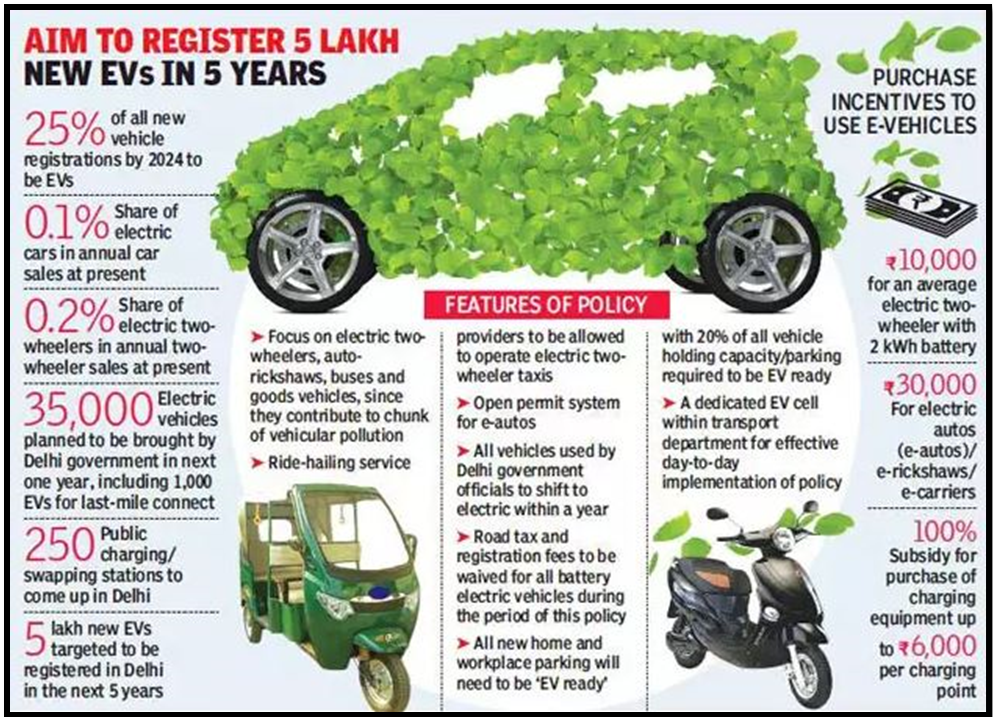SHOULD NOT EVS AND HYBRIDS BE TREATED EQUALLY FOR GOVT. SUBSIDIES?
SYLLABUS:
GS 3:
- Science and Technology- developments and their applications and effects in everyday life.
Focus:
- India’s road transport sector, contributing about 12% to the nation’s CO2 emissions
Source: Hindu
India’s road transport sector, contributing about 12% to the nation’s CO2 emissions, has been a focal point for government efforts to reduce greenhouse gases. The Faster Adoption and Manufacture of Hybrid and Electric Vehicles (FAME) policy, initiated in 2015, aims to promote EVs and hybrids through subsidies and infrastructure development. However, the policy has evolved, and the reduction in subsidies for hybrids has sparked a debate on whether both EVs and hybrids should receive equal treatment in terms of government support.
Contribution of Road Transport to CO2 Emissions
- India’s road transport sector contributes approximately 12% to the country’s CO2 emissions.
- It ranks as the third most greenhouse gas emitting sector after energy and agriculture.
- The Union government has been working on decarbonizing transport for almost a decade.
- The Faster Adoption and Manufacture of Hybrid and Electric Vehicles (FAME) policy was introduced in 2015 to address this issue.
- The policy aims to generate demand for electric vehicles (EVs) and hybrids by subsidizing retail sales and encouraging the manufacture of components.
Evolution of the FAME Policy
- The policy has undergone several changes since its introduction in 2015.
- Subsidies for hybrids have been steadily removed over time.
- Some argue that the lack of charging infrastructure and dependence on imported battery components are significant challenges.
- Critics also point out that the coal-dominated grid increases the overall carbon footprint of EVs.
- The third iteration of the FAME policy is expected to be announced in this year’s Union Budget.
Arguments for and Against Equal Treatment of EVs and Hybrids
Withdrawal of Subsidy for Mild Hybrids
- The government withdrew subsidy support for “mild hybrids” in 2017, affecting popular car models.
- Mild hybrids previously benefited from about 65% of the subsidy component.
- The decision was made to prioritize fully electric vehicles over hybrids.
- This move was intended to push for a more significant reduction in emissions.
- Some believe the decision aligns with the goal of achieving a zero-emissions, energy-efficient India.
Current Market Dynamics
- Approximately 90% of emissions in transport are from road transport, with 20% from passenger cars.
- Two-wheelers constitute 75% of vehicle sales, while three-wheelers make up another 4%.
- The EV market has successfully addressed operational issues in these segments.
- Commercial freight vehicles, which constitute only 5% of the vehicle population, contribute 34% of emissions.
- Hybrids represent a small portion of passenger cars but offer 25-30% fuel efficiency compared to internal combustion engines (ICE).
Environmental Impact and Cost Analysis
- The sustainability of any technology involves life cycle emission analysis (LCA) and total cost of ownership (TCO).
- Studies show that in many cases, emissions from EVs are higher than those from ICE vehicles.
- Hybrids often emerge as the least polluting option when considering the entire life cycle.
- EVs’ environmental impact is significant due to the coal-based power grid and the need for rare earth metals.
- Hybrids, with smaller battery packs, offer a balanced solution in terms of emissions and cost.
Policy and Technological Considerations
Policy Evolution and Sectoral Landscape
- Policies must evolve with the changing sectoral landscape.
- The goal is to achieve zero-emissions vehicles to meet climate and energy security goals.
- The current grid, dominated by coal, affects the overall emissions of EVs.
- There is a need for overlap in transitioning both the energy grid and transport sector.
- The government should specify life cycle emission and GHG norms rather than choosing specific technologies.
Economic and Social Implications
- The total cost of ownership for hybrids is slightly higher due to differential tax rates.
- Hybrids are currently taxed more than ICE vehicles, despite being more environmentally friendly.
- The government’s subsidy policies should not discriminate between technologies.
- Incentives should be based on overall effectiveness and not just on the phase of usage.
- A holistic approach, considering multiple factors and calculations, is essential for effective policy formulation.
Equal Footing for Hybrids and EVs
- Hybrids and EVs should be treated equally for government subsidies.
- There should be no discrimination based on the type of technology.
- Policies should aim for overall environmental benefits and cost-effectiveness.
- The transition towards a greener grid should go hand in hand with electrifying transport.
- The ultimate goal is to reach zero-emissions vehicles to fulfill climate and energy security objectives.
Government initiatives to promote the adoption of electric vehicles (EVs):
|
Source:The Hindu
Mains Practice Question:
Discuss the evolution of India’s FAME policy since its inception in 2015. How has the shift in subsidy focus from hybrids to electric vehicles impacted the overall goals of decarbonizing the transport sector?
Associated Articles:
https://universalinstitutions.com/the-promise-of-hybrid-evs-in-cutting-short-term-carbon-emissions/




